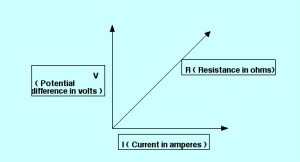State The Relationship Among Volts Amperes And Ohms

Introducing the constant of proportionality the resistance one arrives at the usual mathematical equation that describes this relationship.
State the relationship among volts amperes and ohms. Ohm s law states that the current through a conductor between two points is directly proportional to the voltage across the two points. Voltages are generally expressed in volts with prefixes used to denote sub multiples of the voltage such as microvolts μv 10 6 v millivolts mv 10 3 v or kilovolts kv 10 3 v. The relationships among volts amperes ohms and power made it all so understandable. There is a basic equation in electrical engineering that states how the three terms relate.
We can get the ohms into the act too. Charge flow is caused by volts pushing against ohms so let s get rid of amps in the above equation and replace it with voltage and ohms. The current i in amps a is equal to the square root of the power p in watts w divided by the resistance r in ohms ω. German physicist georg ohm published the concept in 1827 almost 200 years ago.
This forms the equation below. It represents that the current is proportional to the voltage across two points with the constant of proportionality being the resistance. It was later recognized as ohm s law and has been described as the most important early quantitative description of the physics of electricity. This is known as ohm s law.
Ohm s law is a key rule for analyzing electrical circuits describing the relationship between three key physical quantities. The first and perhaps most important the relationship between current voltage and resistance is called ohm s law discovered by georg simon ohm and published in his 1827 paper the galvanic circuit investigated mathematically. The voltage v in volts v is equal to the current i in amps a times the resistance r in ohms ω. Voltage is measured in volts with one volt being defined as the electrical pressure required to force an electrical current of one ampere through a resistance of one ohm.
The voltage v in volts v is equal to the power p in watts w divided by the current i in amps a. Ohm s law states that if the current in a resistor with a resistance r is i then the voltage across the resistor the voltage between the two ends of the resistor is v such that begin matrix v ir left 1 right end matrix where r is in ohm i is in amp and v is in volt. It says that the current is equal to the voltage divided by the resistance or i v r. The voltage is equivalent to the water pressure the current is equivalent to the flow rate and the resistance is like the pipe size.
Where i is the current through the conductor in units of amperes v is the voltage measured across the conductor in. The current is directly proportional to the voltage and inversely proportional to.


















